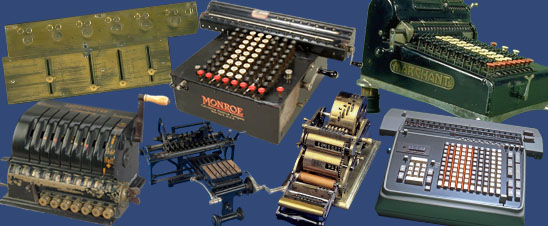This is a very late example of a product of the Monroe Calculating Machine Company of New Jersey, made when the firm was still an independent company.The compact non-printing, full keyboard, electric modified stepped drum calculating machine has a gray steel case and eight column
- Description
-
This is a very late example of a product of the Monroe Calculating Machine Company of New Jersey, made when the firm was still an independent company.
-
The compact non-printing, full keyboard, electric modified stepped drum calculating machine has a gray steel case and eight columns of gray and light gray oblong plastic color-coded number keys, with a zeroing key of the same color at the bottom of each column. Between the columns of keys, and under the light gray plate, are metal rods (visible through windows in the plate) that serve as decimal markers. These are painted red on one side and the same light gray as the plate on the other. To the right of and below the number keys are a variety of function keys, including addition and subtraction bars, keys for moving the carriage, an enter key, a repeat and a non-repeat button, and diverse other keys for division and multiplication.
-
Behind the keyboard is a carriage with a row of eight dials to show a number set up for multiplication, a row of 16 dials to show the result, and a row of eight revolution register dials. These are visible through windows in the carriage. The set up dials for multiplication have a metal frame that slides over them to indicate the position of the decimal point and two digits to the right of the decimal point. It can be placed in seven different positions. A gray plastic knob is at the back on the right side.
-
A mark on the front and back of the machine reads: MONROE. On the back, it is a trademark registered by Monroe in 1956. A mark on the right and left sides reads: MONROmatic. A paper tag glued to the bottom of the machine reads: MONROE (/) CALCULATING MACHINE (/) COMPANY, INC. (/) ORANGE, N.J. U.S.A.; It also has several patent numbers, the largest of which is 2,931,569, the number of a 1955 patent. A metal tag attached to the bottom reads: MODEL CSA 8 (/) SERIAL B930371. In 1958 Monroe became a subsidy of Litton Industries. Many Monroe calculating machines with serial numbers beginning in B date from the 1960s.
-
Reference:
-
Documentation received with the machine, with museum numbers MA.318943.02 through MA.318943.06. This includes an invoice, indicating that it was repaired in 1970.
- Location
-
Currently not on view
- date made
-
1957
- maker
-
Monroe International Corporation, a Division of Litton Business Systems
-
Monroe Calculating Machine Company
- ID Number
-
MA.335384
- catalog number
-
335384
- maker number
-
B930371
- accession number
-
318943
